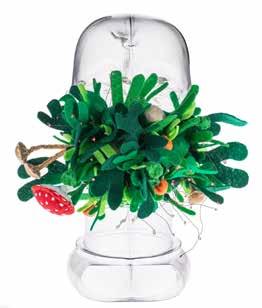
3 minute read
For Our Time



By Leah Best, Head of Knowledge
Collecting BC’s Pandemic Experiences
2. 4.
3.
For Our Time is the name we’ve chosen for an organization-wide project to contextualize British Columbians’ diverse experiences of the COVID-19 pandemic. Spanning seven departments and involving more than 25 staff, For Our Time is a pandemic archive that began in March 2020 and will continue for years to come. More than a collecting project, it is also driving changes in our practice, including the creation of our first crowdsourced collection through submissions to the project websites rbcm.ca/yourstory. It has also been a flashpoint for discussing the act of collecting material culture. Whose experiences do we collect? What biases must we acknowledge, and how do we ensure they are not reflected as gaps in our efforts to document the pandemic? Should we collect at all, at this time, when so many are living with great hardship? These questions, and many more, have been central to framing the direction and scope of our work.
Now, nine months in and on the cusp of a new vaccination phase of the pandemic, staff reflect on their contributions to and experiences of the project to date.
“The For Our Time project has connected the staff at the museum and archives to people from all over British Columbia. Assisting folks with their digital contributions (via the project website), I have often found myself on the phone, and our conversations inevitably lead to us discussing the ways in which the pandemic has affected and shaped our lives. I have had the privilege of hearing personal stories about illness and recovery, loneliness and resilience, anxiety and hope.”
—Genevieve Weber, Archivist “In invertebrate zoology, we continue to address the direct and indirect consequences of the pandemic on biodiversity. While it is too early to provide a definitive answer to how the pandemic is affecting biodiversity, we are mobilizing and using biodiversity data found in natural history collections, as well as community-based observations (from the website and app iNaturalist) collected during this project.”
—Dr. Henry Choong, Curator of Invertebrate Zoology
1. Kate’s brother has Down’s Syndrome and is in a care home. Kate would visit through the window, and her brother could not understand why they couldn’t be together, but the hands against the glass helped. Photograph courtesy of Kate Seymour.
2. Jasse Aujla (in the striped shirt), educator, with her EA and only student in class when school started back up in June. Another student joined after two weeks. Photograph courtesy of Jasse Aujla. 3. Since the pandemic began, Lisa has been creating a drawing or painting every day, as a way to share “hopeful messages.” Photograph courtesy of Lisa Maas.
4. Tywla Exner, an artist in Prince George, brought her interests in the natural world to a mask she created early in the pandemic, Forest Filter. “I’ve been working on developing a new content platform. We’ve hired a business analyst to review requirements and research other institutions. Not just who is doing it, but who is doing it well. The benchmark site we aspire to is a partnership between the National Museum of African American History and Culture and the Smithsonian. Their site is communitycuration.org, and it’s a fine example of the design and technology getting out of the way to provide a seamless user experience that visitors would likely find appealing and easy to use.”
—Dave Stewart, Digital Manager
“I’ve worked with Genevieve Weber and with my colleague Angie Pass (registrar) to determine the data requirements of registering approximately 260 community-sourced digital materials in our database, IMM. We standardized the input to allow for future researchers to find them in our collections management system. This was an entirely new way of collecting for us, allowing for direct participation and donation into our collection, revealing personal experiences of these ‘unprecedented times.’”
—Caroline Davies, Senior Registrar “Along with artwork offered through the website, the museum has also set about collecting works from artists who have responded to this shared moment in history. These will be the first non-Indigenous contemporary artworks to enter the art collection since the 1970s. Artists include Twyla Exner, David Ellingsen and Adad Hannah. Indigenous Collections, which has been working with contemporary artists continually, will add masks by artists Howard LaFortune, Joe David and Dorothy Grant.”
—Dr. India Young, Curator of Art and Images
For Our Time is supported by financial contributions from the Royal BC Museum Foundation, the Joan and John Walton Innovation Fund (through the Royal BC Museum Foundation), and BC Parks.










